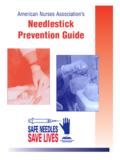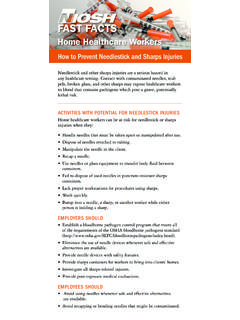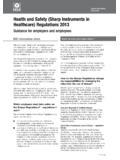Transcription of Needlestick Protocol: WHAT TO DO
1 Needlestick protocol : what TO DOIf you are exposed to a needle stick , splash in the eye, or other high-risk exposure:1. Immediately dispose of sharps safely, if Explain to the patient that you will now transfer their care to another clinic worker, while you care for your injury, and ask them to wait for this Notify your replacement clinic worker that you are activating the Needlestick protocol : Both you and the patient will be tested for communicable diseases ( , receive free HIV and hepatitis testing through the HIV Alliance/ needle Exchange). This is NOT optional. The clinic worker must obtain and document the patient's risk status (remote and recent injection or needle use of any kind; blood transfusions, with year; known disease history).
2 Before the patient leaves the clinic, their correct contact information must be documented, for follow-up of this testing. Before the patient leaves the clinic, they must be given written contact information for the HIV Alliance/ needle Exchange, and instructed to visit them for free testing:HIV Alliance/ needle Exchange phone, 541-342-5088. Location, 1966 Garden Avenue, Eugene. ( needle Exchange has mobile sites throughout the week - call for details.)Alternatively, the patient may visit their personal physician; document this physician's contact information before the patient leaves the clinic, for followup. Notify the patient that IF official documentation of recent negative HIV and hepatitis B/C testing is provided by medical authorities, no new testing or treatment are Clean the wound thoroughly with alcohol-based hand sanitizer (containing at least 60% alcohol, which kills HIV, HBV, and HCV), or rinse eye/s very thoroughly with fresh water or sterile saline solution.
3 Do not squeeze a puncture wound - it causes microtrauma and swelling, and doesn't Document the date, time, route of exposure, and patient and staff risk factors for blood-borne diseases. Deliver this information to the clinic manager. The clinic manager is to open a file to document: staff member's exposure 's and staffer's test results (rapid HIV, HBsAg, anti-HBs antibodies, anti-HCV) 's and staffer's treatment plans (post-exposure prophylaxis/PEP and followup care, including emotional support and education) Do NOT leave the clinic yourself, without a prescription for post-exposure prophylaxis (PEP, preventive medication) that you can fill and take within 2 hours of exposure, OR SOONER.
4 See below for possible regimens. Do NOT leave the clinic yourself, without documenting the injury/exposure, notifying the clinic manager, and planning your testing and treatment Immediate testing: The patient: The patient should be rapid-tested for HIV (results within an hour), with a positive result followed by a Western blot for confirmation. Negative rapid tests do NOT require further testing. The patient should be tested for hepatitis (HBV surface antigen, HBsAg, and anti-HCV antibodies) staffer: If the patient's rapid HIV is negative, the staffer does NOT need HIV testing, other than routinely, or treatment (PEP).
5 If the patient is HIV positive, the exposed staffer should be tested for HIV immediately and at 6 and 12 weeks, and 6 months after exposure. Most people seroconvert in the first 3 months, if at all. The staffer should be tested for hepatitis on the basis of the patient's results. See below for HIV post-exposure prophylactic (PEP) treatment: If the patient's HIV status is unknown, take immediate post-exposure prophylaxis medication (PEP) while waiting for the patient's rapid HIV test results. If the patient is thought to be very low risk, you can wait 1-2 hours before starting PEP medication while awaiting rapid HIV testing.
6 If no results within 2 hours, start PEP immediately. (You can stop the PEP if the patient later turns out to be HIV negative.) If the patient is known to be HIV positive, start PEP immediately, and plan to continue it for 4 is most effective if started within 1-2 hours of exposure, or what drugs for HIV-PEP?Call the National Clinicians' Postexposure Prophylaxis Hotline (PEPline, 888-448-4911).Possible regimens: Preferred: Truvada (tenofovir/emtricitabine, 300/200 mg daily) plus Isentress (raltegravir, 400 mg twice daily). Alternative: Truvada (tenofovir/emtricitabine, 300/200 mg daily) plus Reyataz (atazanavir, 300 mg daily) and Norvir (ritonanvir, 100 mg daily),OR Truvada (tenofovir/emtricitabine, 300/200 mg daily) plus Prezista (darunavir, 800 mg daily) and Norvir (ritonanvir, 100 mg daily) with food.
7 Additional possible regimens: Atripla (efavirenz/tenofovir/emtricitabine, 600/300/200 mg daily),OR Truvada (tenofovir/emtricitabine, 300/200 mg daily) plus Kaletra (lopinavir/ritonavir, 400/100 mg twice daily),OR Zerit (stavudine, 30 mg twice daily) and Epivir (lamivudine, 150 mg twice daily) in place of tenfovir/emtricitabine in the above regimens if the latter is contraindicated. For pregnant workers: Combivir (zidovudine-lamivudine, 150/300 twice daily) and Kaletra (lopinavir/ritonavir, 400/100 mg twice daily). Efavirenz should not be used in women who are or might be pregnant. Drugs that should NOT be used are abacavir (Ziagen) and nevirapine (Viramune), which may cause severe and sometimes life-threatening side effects, especially during the first few weeks of exposure.
8 ( Updated 3/28/2012.)Drug prices at Costco (online, 12/2012):Truvada 200/300mg #30, $1278; #60, $2520; #90, $3761(rev. transcriptase inhib.)Isentress 400mg #60, $1133; #120, $2228; #180, $3325.(integrase inhibitor)Kaletra 200/50mg #30, $211; #50, $343; #100, $671.(protease inhibitor)Atripla #30, $1889; #60, $3752; #90, $5615.(rev. transcriptase inhib.)Others on the above list are not found from this to take HIV-PEP medication for 4 weeks or longer. If the patient is found to be HIV-negative, you can stop the PEP Hepatitis B testing and treatment: If the patient is HBV negative, you might not need further testing.
9 If you have been vaccinated against hepatitis B, get tested to verify that you are immune, you will have positive anti-HBs (antibodies to hepatits B surface antigen, which is used to make the vaccine). You might not need further you are not immune, and the patient is positive, (had a poor response, or the vaccine wore off), you will need to be treated as though unvaccinated. HBV-PEP consists of HBIG ("Hepagam," hepatitis B immunoglobulin, , repeated in one month if not HBV immune) and/or hepatitis B vaccination (a 3-shot series).10. Hepatitis C testing and treatment: If the patient is HCV negative, you don't need further testing for HCV, although CDC recommends that adults born in 1945-1965, those who got blood before 1992, and many others with "mild" risk factors, get screened routinely for anti-HCV antibodies.
10 If the patient is HCV positive, get follow-up testing for HCV RNA by PCR 4-6 weeks after follow-up testing for anti-HCV antibodies by ELISA, HCV RNA, and liver enzymes (ALT and AST) 4-6 months after exposure. There is currently no PEP or vaccine for hepatitis C. Immunoglobulin (HCIG) and antiviral agents are NOT recommended. Consult your personal physician or a liver specialist for latest CDC data, see protocol ChecklistCompleted by _____ Date ____/____/_____ Exposed staffer name/DOB _____ Contact info_____Patient contact info _____Patient risk status (hx blood borne illness, IVDU, transfusion, MSM, etc.) _____Time, date, and route of exposure _____HIV testing: Patient had rapid HIV test* Result negative > no further HIV testing needed Result positive > sent for Western blot confirmation Result positive > staffer tested for HIV > staffer to doctor for managementHepatitis testing.







